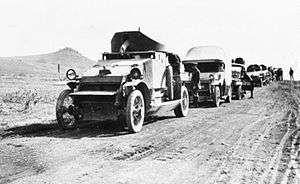Lanchester 4x2 Armoured Car
| Lanchester Armoured Car | |
|---|---|
 | |
| Type | Armoured car |
| Place of origin |
|
| Specifications | |
| Weight | 4.7 t |
| Length | 4.88 m |
| Width | 1.93 m |
| Height | 2.29 m |
| Crew | 3-4 |
|
| |
| Armour | up to 8 mm |
Main armament | Vickers machine gun (turret) |
Secondary armament | Lewis Gun (stowed inside) |
| Engine |
6-cylinder 60 hp (45 kW) Lanchester petrol engine |
| Power/weight | 12.8 hp/tonne |
| Suspension | 4x2 wheel |
| Speed | 80 km/h |
The Lanchester Armoured Car was a British armoured car derived from the Lanchester Sporting Forty touring car produced during the First World War.
It should not be confused with the later interwar period six-wheeled development.
History
In 1914, the Lanchester was the second most numerous armoured car in service after the Rolls-Royce. Designed by the Admiralty Air Department for the Royal Naval Air Service Armoured Car Section in France it was intended to support air bases and retrieve downed pilots.[1] A prototype was produced in December 1914 with production following in early 1915.
A number of changes were made; principally strengthening the chassis and suspension, and doubled rear wheels fitted to the rear axle to improve traction, weight distribution. The vehicle had a distinctive circular turret with a narrow horizontal roof with central hatch, steeply sloped at the sides, and continuous sloped bonnet plating. This last, together with a much more compact form than the earlier Rolls Royce Armoured Car achieved by positioning the driver beside the powerful and reliable engine, which featured an epicyclic gearbox) gives the Lancaster a deceptively modern appearance that matches its paper specification when compared with its later inter-war 6x4 version.
Thirty six of the production version were sent to France in May 1915, one twelve-car RNAS squadron served with the Belgian Army. In addition, Belgium received between 10 and 15 cars on loan from the RNAS.
On the Western Front it served its intended purpose despite what were considered advanced features. However, with the rough road conditions and even rougher cross-country treks the 4x2 Lanchester chassis caused difficulties which were never satisfactorily resolved, limiting its usefulness.
In 1915, all thirty six RNAS armoured cars were passed to the British Army. Since the BEF had acquired a variety of armoured cars, and this represented a challenge in terms of maintenance, stores and training it was decided, given trench warfare had severely limited the role that armoured cars could play, that the British Expeditionary Force should standardise on a single type, selecting the Rolls Royce[2] Accordingly, all Lanchester armoured cars were returned to Britain.
After being overhauled, 22 vehicles were supplied to the Imperial Russian Army in December 1915. Of these 19 were later rearmed with a 37-mm naval Hotchkiss gun in place of the standard Vickers machine gun. In January 1916 more Lanchesters arrived with the RNAS expeditionary force[3] deployed in the Caucasus, Romania and Galicia in support of the Russians. RNAS detachments were sent as far as Persia and Turkey and the Lanchesters travelled many thousands of miles until, in early 1918, the expedition force departed Russia via Murmansk.
Jack Livesey in Armoured Fighting Vehicles of World War I and II[4] wrote
"Operating in climates ranging from desert to near-Arctic conditions... during their time in Russia these cars covered 85,295km/53,000 miles. [They] were deployed in a manner that would become the standard for AFV warfare in the 20th Century. Acting as scouts and armed raiders, they operated well forward of the infantry following in their armoured trucks. When operating alongside the infantry they would act as fire-support vehicles..."
Their last operation was in support of the Brusilov Offensive in mid 1917.
Following this deployment Russia descended into civil war and the RNAS armoured car division was withdrawn back to Britain, while Lanchesters still in Russian hands were used by the White Russian forces.
During most of its service life, the Lanchester was considered an admirably fast and reliable vehicle, the only caveat being limitations imposed by the chassis.
Variants
Vehicles received by the Russian Army were fitted with a small cupola on the turret and with side shields for the machine gun.
External links
| Wikimedia Commons has media related to Lanchester 4x2 Armoured Car. |
- Tanks ! (Dead link)
Notes
- ↑ Trewhitt, Philip (1999). Armoured Fighting Vehicles. Dempsey-Parr. p. 150. ISBN 1-84084-328-4.
- ↑ http://www.tankmuseum.org/museum-online/vehicles/object-e1949-329
- ↑ http://navymuseum.co.nz/worldwar1/ancillary-forces/armoured-cars/
- ↑ Livesey, Jack (2007). Armoured Fighting Vehicles of World Wars I and II. Hermes Hse 88-89 Blackfriars Rd, London SE1 8HA: Anness Publishing Ltd. p. 63. ISBN 978-1-84476-370-2.